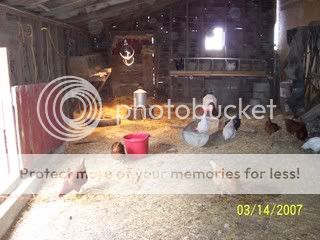AK-Bird-Brain-Wife here, located on the Kenai Peninsula, Alaska... with some photos of the chicken coop and the insulation. The coop is built 2" R-19 foam board sandwiched between two sheets of 1/2" plywood (the floor is 3/4"). My DH wired it for lights/heat, and I keep two to three heat lamps in there during the winter. He may have said this before, but I keep one red one on all the time aimed at the water to keep it from freezing. Then there is another red and one white one, on timers, for the hens. The white one is on during the "day", and the red one is on at night, to help simulate more equalized daylight hours. There's about an hour overlap, so they get a little extra heat early in the morning when it's the coldest.
We just replaced the original roofing with zinc/aluminum sheeting to help with snow removal. Here's the coop before:
We used the "metallic bubblewrap" to insulate the ceiling, which helps keep it cooler in the summer (it was like a greenhouse before) and warmer in the winter.
We have a wireless sensor that transmits the inside temperature to a base we have indoors so I can monitor the temps for my girls.
Then, in the middle of the winter, DH created a sort of awning out of the same metallic bubblewrap, and we suspended the heat lamps under it. It "lowered" the ceiling and trapped the heat in there closer to the chicken's roosts and nest boxes.
I don't have a picture of that, since it's down right now... sorry. As you can see, we had a little moisture/mildew problem with the original design (I tagged it with bleach water) but now there's hardly any buildup at all.
Here's a picture of the expansion in progress.
We're adding a covered outdoor area to give the chickens more snow-free area (and hopefully less muddy!) and more than doubling the size of the run. We're thinking of keeping them compartmentalized, though, so we can segregate aggressive hens, or ones that aren't well if we need to. As it gets colder and we start adding back the insulation and heat sources, we'll add more photos. Hope this helps!







